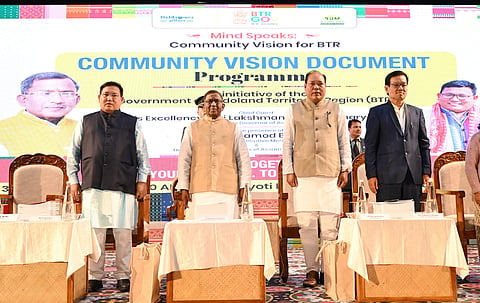
- Home
- Live Blog
- Breaking News
- Top Headlines
- Cities
- NE News
- Sentinel Media
- Sports
- Education
- Jobs

Mending demographic fault lines is critical to ensuring hard-won peace in the Bodoland Territorial Region (BTR) from becoming fragile. Inclusive growth is a necessary condition for sustainable growth in an area with multiple communities as stakeholders. The “BTR Community Vision Document” is a laudable initiative to create the space for communities living in BTR areas to express their visions of development for equal and inclusive growth. The governance sharing model of the Bodoland Territorial Council under the Sixth Schedule has its own limitations in granting equal rights of representation in the elected autonomous council. The territorial council has its seats reserved for Scheduled Tribes living in BTR areas, and the Bodos, comprising about 90% of the ST population, have the lion’s share in the tribal autonomous council. The constitutional provisions for BTC under the Sixth Schedule leave other non-ST communities living in BTR, who account for about 66% of the population, excluded from the decision-making process. The mismatch between demography and stakes in political power kept the demographic fault lines in BTR exposed, posing a challenge to the sustainability of peace, which was achieved after all militant outfits fighting for Bodo statehood returned to the mainstream and signed the third Bodo Accord in 2020 for more autonomy to the largest plains tribe community of Assam. The Community Vision document is the culmination of the Bodoland Happiness Mission launched by the BTC authorities two years ago in a bid for reconciliation among all communities living in BTR that were affected by violent ethnic clashes, displacement, and trust deficit. A sense of deprivation from various development activities prevailing among various non-ST communities widened the trust deficit, and the Community Vision Document is an innovative approach to bridge the gap. The communities getting an opportunity to articulate their aspirations in the document is expected to lay the foundation of trust building, which is essential for sustainable and inclusive development. The BTC authorities are planning to come up with its own Vision Document in March, and the proposed document of the council reflecting the issues and aspirations of all communities in the Community Vision Document will be crucial for achieving the goal of making the communities equal stakeholders in the development process in BTR. Land issues, including encroachment of tribal belts and blocks in BTR areas, are among the key issues that remained unsettled in BTR even after the signing of three Bodo Accords. BTC authorities achieving 100% digitisation of land records has raised hopes for identification of reserved and unreserved land to address the land issue. The land issue needs urgent and focused action-based attention from the BTC authorities, as the encroachment of vast tracts of forest land has already made several areas of BTR a hotbed of human-elephant conflict in the state. Ensuring equal access to better education and healthcare for every community living in BTR can go a long way in improving human development indices. The high dropout rate at the secondary education stage continues to pose a great hurdle towards achieving this goal, which needs to be addressed through improvement in school infrastructure and recruitment of quality teachers for improving the teaching-learning ecosystem. Access to quality education builds confidence among the communities and the BTC authorities. Improving education in every single village can be the first important step towards ending the sense of deprivation among various communities and instilling confidence in the governance of the autonomous council. The BTC authorities have categorised the issues and subjects included in the Community Vision Document into three categories: issues that can be addressed by BTC authorities, state governments, and those that can be addressed only by the central government. Communities explaining this and giving wider publicity to the issues at hand for BTC authorities and identifying the issues to be addressed by the State or Central Government will bring more transparency to the implementation of the Vision document as a guiding document for governance in BTR. Identifying key development initiatives, such as connectivity projects, boosting agricultural and horticultural production, and supporting livestock rearing and dairy farming across the BTR and in every single village belonging to all the 26 communities residing in the territorial region, will ensure that development is uniform and that livelihood opportunities created are not confined to specific areas. Agriculture, livestock rearing, handloom, and handicraft account for the largest share of livelihoods for all communities in BTR, and the BTC authorities prioritising these sectors is a pragmatic approach towards ending the trust deficit and imbibing the sense of equality among all communities. BTR, being the gateway to Bhutan, enjoys a geographic advantage to derive benefits from the mega development push by the Himalayan Kingdom for trade, commerce, and cross-border connectivity. Inclusive development in BTR will be an added advantage to leverage these opportunities. The bottom-up approach in the preparation of the vision document has strengthened hopes for inclusive development in BTR in the New Year.